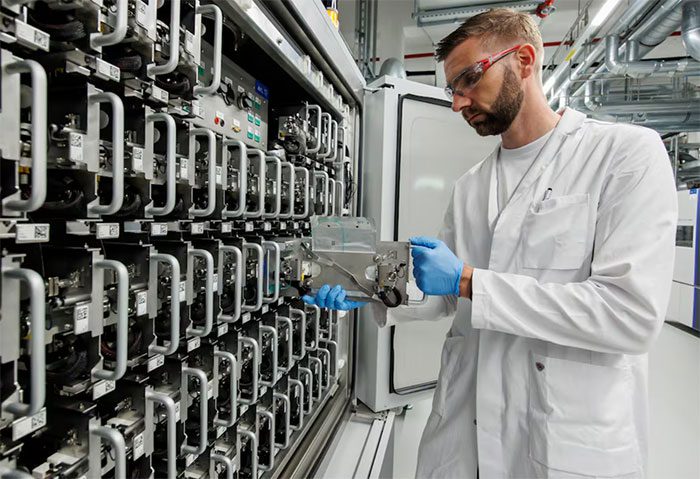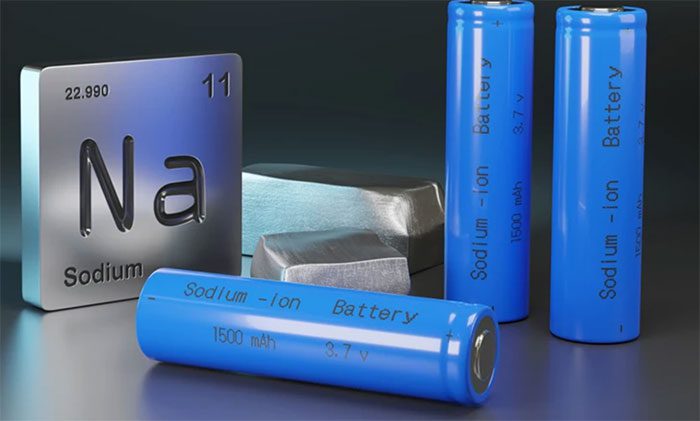The world is racing to find alternatives to lithium-ion batteries, anticipating that the demand for this type of battery will surge by 60 times in just two decades.
The use of elements such as lithium, cobalt, and nickel in battery production has highlighted the world’s dependence on scarce and expensive toxic materials. Furthermore, the extraction and processing of these materials also pose significant environmental challenges. It takes two million liters of water to extract 1,000 kg of lithium.
As a result, researchers are urgently seeking alternative materials that are abundant, renewable, biodegradable, safe, cost-effective, and have a lower environmental impact. According to forecasts by the European Union, solutions may be on the horizon, with sodium and calcium – two abundant elements currently being researched in preparation for the anticipated 60-fold increase in lithium demand over the next two decades.
Currently, society faces two major challenges: the electrification of transportation and the storage of renewable energy for continuous power supply.
John Abou-Rjeily, a researcher at Tiamat Energy, part of the French National Center for Scientific Research (CNRS), which develops and produces sodium materials, stated: “There aren’t enough lithium-ion, cobalt, and nickel batteries to meet everyone’s needs.”
This physicist and materials chemist is exploring the potential of sodium – one of the most abundant chemical elements in the Earth’s crust, which is also a safer and cheaper alternative to lithium.

A Volkswagen employee testing batteries at the electric car battery production facility on May 18, 2022, in Salzgitter, Germany. (Photo: Getty Images).
However, sodium-based materials require more space, which is why sodium batteries are not suitable for very small devices. They also cannot compete with the current fuel storage systems available for electric cars but could serve as alternatives on shorter routes. Mr. Abou-Rjeily explains: “While I never challenge the 500 km range of lithium-ion batteries, sodium-ion batteries may be more competitive for short to medium-range electric vehicles.”
Scientists believe that a shift in perception will further promote the application of sodium as an alternative, as it would allow this technology to be deployed right at home and workplaces in the form of energy storage systems from renewable sources. This goal is pursued by Magdalena Graczyk-Zajac, a visiting professor at Darmstadt University of Technology in Germany, and a member of the European SIMBA project, an EU-funded initiative aimed at developing sodium-ion batteries for households, which will conclude its first research phase in June.
Researcher Graczyk-Zajac is committed to finding ways to store energy harvested from home photovoltaic panels in rechargeable sodium-ion batteries. This method will provide energy for homes and charge residents’ electric vehicles at a significantly reduced cost. She states: “You could drive for free [energy] for 8-9 months of the year.”
Currently, a prototype has been tested in the laboratory. One part of the battery, the anode, is made from hard carbon, which can be produced from wood or biomass waste. The other part, the cathode, can be made from a material called “Prussian white” (PW) – a sodium-rich chemical compound, which is one of the most common metallic elements.

Sodium-ion batteries. (Photo: Energysource).
The CIC energiGUNE research center in Spain is making its own strides in this field, having created a sodium metal anode that is only 7 microns thick (70 times thinner than current anodes) thanks to the application of a physical vapor deposition process. According to CIC energiGUNE, this advancement opens up the opportunity to produce flexible solid-state batteries with thin sodium anodes, offering a safer, cheaper, and more compact alternative to current liquid electrolyte batteries that use graphite.
Montse Galcerán, the lead researcher of the project, explains: “Sodium cannot be easily thinned due to its sticky structure, similar to that of flexible plastic. Until now, the most common method for rolling a block of sodium has been as basic as hammering it, but this means it is impossible to achieve a thin and uniform sheet, and thus a large amount of sodium remains unused in the battery. However, thanks to the vaporization method, we have overcome that obstacle.”
This thinning of the anode allows researchers to reduce the amount of sodium needed as well as decrease costs, weight, and size of the battery while increasing energy density (greater storage capacity) and safety.
Another element being used as a substitute for lithium is calcium. “It is one of the most abundant elements in the Earth’s crust and is not concentrated in specific geographical areas like lithium,” said Rosa Palacín from the Barcelona Institute of Materials Science (ICMAB-CSIC) and a member of the CARBAT project, adding that if raw materials are cheap, then batteries can also be inexpensive.
Using calcium as the cathode offers advantages over graphite in lithium-ion batteries because it has a higher energy density accumulation per kg compared to conventional lithium batteries. This type of battery also forms small hard structures called dendrites that can cause short circuits or explosions after repeated use.
“When calcium passes through the electrolyte, two electrons will flow out, instead of one as in the case of lithium. It can be assumed that a battery of the same size will provide higher autonomy if used in electric vehicles, as long as a suitable anode is found,” Palacín explains.
Other researchers from the Technical University of Denmark are also looking for a battery made from aluminum anodes and sulfur cathodes. Aluminum is even more abundant than calcium, but incorporating it into batteries poses similar challenges.
“All the materials used are cheap. Aluminum, sulfur, electrolytes, and urea are very inexpensive. Even polymers are too,” said researcher Juan Lastra, who advocates for using this method to serve energy storage from wind or solar parks.


















































